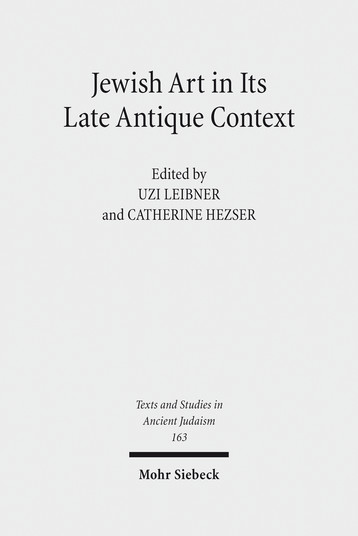History
Jewish Art in Its Late Antique Context
Ed. by Uzi Leibner and Catherine Hezser
[Jüdische Kunst in ihrem spätantiken Kontext.]
184,00 €
including VAT
including VAT
cloth
ISBN 978-3-16-154388-3
available
Also Available As:
Published in English.
The contributions to this volume examine the emergence of ancient Jewish art from the interdisciplinary perspective of scholars in Art and Archaeology, Ancient Judaism and Rabbinics, Patristics and Church History. They evaluate the manifold ways in which late antique and early Byzantine Jewish art was embedded in its Hellenistic and Roman cultural context by, at the same time, evincing specifically Jewish and local Near Eastern idiosyncrasies. Since the Graeco-Roman context was shared with early Christian art, some formal similarities are recognizable, whereas the meanings associated with the images would have differed. A study of the relationship between the literary sources (the Hebrew Bible, Jewish Hellenistic and rabbinic literature) and the artistic depictions is crucial for a proper understanding of ancient Jewish art. Similarly important are the artistic analogies appearing in Graeco-Roman and early Christian contexts. Of particular interest is the question why Jewish figurative art developed in the Land of Israel in late antiquity only: which political, social, economic, religious and cultural constellations may have led to the emergence of figurative art? How do these images relate to biblical commandments advocating aniconism and what would rabbis have made of them? Was Erwin Goodenough correct about a dichotomy between »popular« synagogue art and an aniconic rabbinic Judaism? The Jewish use of images with analogies in pagan (and sometimes also Christian) contexts is particularly striking: what led Jews to adopt images such as the zodiac and pagan mythological figures and scenes and how were they combined with images based on biblical narratives? The volume shows how an interdisciplinary approach leads to a better understanding not only of ancient Jewish, but of Graeco-Roman and Christian art as well.Survey of contents
Catherine Hezser/Uzi Leibner: Jewish Art in its Late Antique Context: An Introductory EssayPart I: The Development of Jewish Art in the Roman-Byzantine Period
Orit Peleg-Barkat: Interpreting the Uninterpreted: Art as a Means of Expressing Identity in Early Roman Judaea – Lee I. Levine: Why Did Jewish Art Flourish in Late Antiquity? – Peter Stewart: The Bet Alpha Synagogue Mosaic and Late-Antique Provincialism – Rina Talgam: From Wall Paintings to Floor Mosaics: Jewish and Christian Attitudes to Figurative Art
Part II: Synagogue Mosaic Panels
Zeev Weiss: Decorating the Sacred Realm: Biblical Depictions in Synagogues and Churches of Ancient Palestine – Uzi Leibner: Rabbinic Traditions and Synagogue Art – Roland Deines: God's Revelation Through Torah, Creation, and History: Interpreting the Zodiac Mosaics in Synagogues
Part III: Symbols and Iconography
Rachel Hachlili: Why Did the Menorah and Not the Showbread Table Evolve into the Most Important Symbol of Judaism? – Catherine Hezser: »For the Lord God is a Sun and a Shield« (Ps. 84:12): Sun Symbolism in Hellenistic Jewish Literature and in Amoraic Midrashim – Karen B. Stern: Celebrating the Mundane: Figural Graffiti and Daily Life among Jews in the Levant
Part IV: Jewish and Christian Art
Markus Vinzent: Earliest 'Christian' Art is Jewish Art – Sean V. Leatherbury: Competitive Sacrifice: Christian Visual Engagement with Jewish Sacrificial History and the Temple in Late Antique Arabia – Robin M. Jensen: The Three Hebrew Youths and the Problem of the Emperor's Portrait in Early Christianity – Holger Zellentin: The Rabbis on (the Christianisation of) the Imperial Cult: Mishnah and Yerushalmi Avodah Zarah 3:1 (42b, 54–42c, 61)
